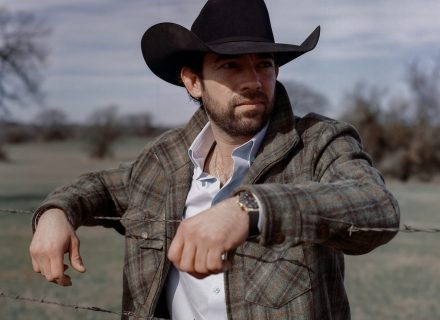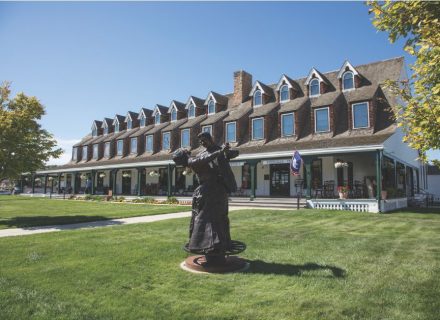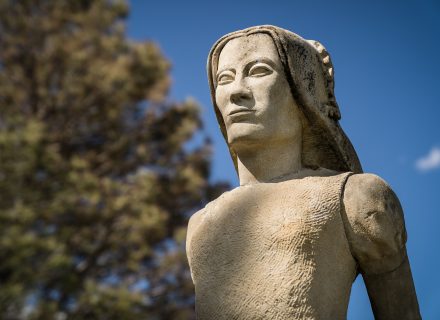Go to Annie Oakley’s home state of Ohio — or follow her trail online, onscreen, in a book, and at the range.
1. Travel the Annie Oakley Trail.
Born in rural Darke County, Ohio, in 1860, Oakley lived for a time with husband Frank E. Butler in Cincinnati, where the two met in a shooting contest (she won) when she was just 15. But it’s Greenville, Ohio, where she died in 1926, that’s made itself her official town. About 30 miles northwest of Dayton, Greenville is home to the National Annie Oakley Center at the Garst Museum, where you can see her rifles, costumes, and memorabilia and discover that “Unlike Hollywood’s image of a wild west, rough-and-tumble tomboy, Annie was a petite woman who loved lace, silver, beautiful furnishings and elegant clothing,” according to the museum. Also on the trail in Greenville: the larger-than-life-size bronze of her in the Annie Oakley Memorial Plaza and the “Little Sure Shot” mural on the exterior of the Sure Shot Tap House, where you can lift a cold one to the namesake, especially if you’ve adjourned there in July after Greenville’s annual Annie Oakley Festival. If you want to pay your respects by making a pilgrimage to her final resting place, she is buried with husband Frank Butler, in Darke County, in Brock Cemetery, about eight miles from her birthplace. Find out more at ohio.org.
2. See her shoot.
More proof that the Library of Congress is doing a stellar job preserving our American treasures: Go to loc.gov (or YouTube) to see 21 seconds’ worth of Annie Oakley doing some impressive fringe-flying rifle shooting at stationary and moving objects in 1894. The Kinetoscope film by Edison Manufacturing Co. was shot in the world’s first film studio, Thomas Edison’s Black Maria, in West Orange, New Jersey. William Heise was manning the rudimentary movie camera, which Edison had invented only about four years previously.
3. Watch the movie.
Annie Oakley, the 1935 film by director George Stevens, stars Barbara Stanwyck. The first western for both director and star, it’s based on the real life of Annie Oakley but took liberties with historical details in the retelling of Oakley’s romance with husband Frank E. Butler rather than reciting her career as a showstopping sharpshooter.
4. Check out the TV series.
On YouTube, you can watch some of the 81 episodes of the weekly show Annie Oakley, which ran from January 1954 to February 1957, with Gail Davis playing the famous sharpshooter in highly fictionalized storylines. Gene Autry was an executive producer, and Fess Parker, Slim Pickens, and Lee Van Cleef, among many others, show up in different episodes.
5. Listen to Annie Get Your Gun.
On Apple Music, you can find the 2000 remaster of the original cast recording of the 1946 Broadway musical Annie Get Your Gun. That’s Ethel Merman (who also starred in the 1966 revival), Ray Middleton, and Marty May singing Irving Berlin classics like “There’s No Business Like Show Business” and “Anything You Can Do (I Can Do Better).” The musical won a 1999 Tony for best revival. The 1950 Technicolor screen version starred Betty Hutton and Howard Keel.
6. Read her life story.
Historian and curator Paul Fees recommends Annie Oakley, Woman at Arms: A Biography by Courtney Ryley Cooper, originally published in 1928, because it was the first biography of Oakley and was written by a contemporary who had firsthand sources. Here are just some of the many other books that will immerse you in the Annie Oakley story: The Colonel and Little Missie: Buffalo Bill, Annie Oakley, and the Beginnings of Superstardom in America, a dual biography by Larry McMurtry; The Life and Legacy of Annie Oakley by Glenda Riley (the University of Oklahoma Press); Annie Oakley by Shirl Casper (Oxford University Press); Annie Oakley: Young Markswoman by Ellen Wilson (Simon & Schuster’s Childhood of Famous Americans series for young readers); Missie: The Life and Times of Annie Oakley by Annie’s niece Annie Fern Swartwout (Coachwhip Publications).
7. Take up trapshooting.
You’ll find the Trapshooting Hall of Fame, Museum, & Research Library in Sparta, Illinois, where they have on display one of Annie’s glass target balls — filled with confetti and with a wax seal with AO stamped on it — and bound magazines going back to the mid-1800s. If you want to hone your own skills, you can find amateur trapshooting associations and contests around the country. Get more information at the Amateur Trapshooting Association website.
For more information about Annie Oakley and Frank Butler and Buffalo Bill’s Wild West show, visit garstmuseum.org, centerofthewest.org, and annieoakleycenterfoundation.org.
Read Annie Oakley by the Numbers and our feature from the October 2024 issue.


















